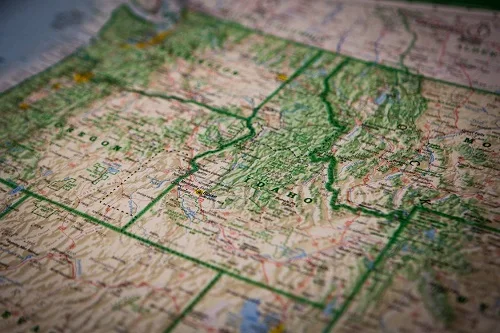Índice
Surveying and Geomatics is a field dedicated to measuring and understanding the Earth's surface. It involves the collection, analysis, and interpretation of spatial data to create accurate maps, charts, and three-dimensional models. From determining property boundaries to monitoring environmental changes, surveying and geomatics play a critical role in various industries and sectors.

Surveying and Geomatics encompass a broad range of activities, including land surveying, surveying and mapping, and geographic information systems (GIS). Land surveying focuses on determining the precise location and dimensions of land parcels, while surveying and mapping involves creating detailed representations of the Earth's surface. GIS technology allows for the analysis and visualization of spatial data to support decision-making.
Professionals in surveying and geomatics perform a variety of tasks depending on their specialization. Professional land surveyors are responsible for establishing and marking land boundaries, conducting property surveys, and preparing legal descriptions. Surveying technicians assist surveyors in field work and data collection. Geoinformation engineers, on the other hand, focus on using GIS and other technologies to analyze spatial data and create information products.
To enter the field of surveying and geomatics, individuals typically need to complete a geomatics program at a college or university. These programs offer a combination of theoretical knowledge and practical experience in surveying and engineering. Some positions may require additional certifications or licenses.
Surveying and Geomatics comprises several specialized areas:
Advancements in technology have revolutionized the field of surveying and geomatics. Global Positioning System (GPS) and other satellite-based systems have significantly improved the accuracy and efficiency of data collection. State-of-the-art surveying equipment such as total stations, laser scanners, and unmanned aerial vehicles (UAVs) have expanded the capabilities of surveyors.
Surveying and geomatics have a wide range of applications across various industries. In real estate, accurate property surveys are essential for property transactions. In civil engineering, surveying and geomatics data is used for design and layout of infrastructure projects. Environmental scientists rely on remote sensing to monitor land cover changes and natural hazards. The possibilities are endless, and the field continues to evolve.
The field of surveying and geomatics offers a diverse range of career opportunities. Graduates with degrees in geomatics engineering technology or related fields can find employment in various sectors. Engineering firms, government agencies, and private companies are among the primary employers.
Entry-level positions often involve working as surveying technicians or data analysts. With experience and further education, professionals can advance to roles such as project managers, GIS analysts, or professional land surveyors. The demand for skilled professionals in surveying and geomatics is expected to grow as technology continues to advance and the importance of spatial data increases.
Surveying and geomatics play a critical role in modern society. Accurate and up-to-date geospatial information is essential for a wide range of activities, from urban planning and transportation to environmental management and disaster response. By providing the foundation for understanding our world, surveying and geomatics contribute to sustainable development, economic growth, and public safety.
Surveying and Geomatics play a pivotal role in the real estate and construction industries. Accurate land surveying is essential for property boundary determination, site analysis, and legal descriptions. Topographic surveys provide detailed information about the land's elevation, slopes, and drainage patterns, which is crucial for site planning and development. Construction layout relies heavily on precise surveying data to ensure the accurate placement of buildings, structures, and utilities.
Moreover, surveying and geomatics support sustainable development by assessing environmental impacts and monitoring land use changes. By utilizing GIS technology, professionals can analyze site suitability, optimize land use, and minimize environmental disturbances.
The field of surveying and geomatics faces both challenges and opportunities. Technological advancements, such as the increasing use of drones and lidar, have expanded data collection capabilities but also require specialized skills to process and analyze the resulting data. Additionally, the integration of surveying and geomatics with other disciplines, like civil engineering and environmental science, presents new challenges and opportunities for collaboration.
Despite these challenges, the demand for skilled professionals in surveying and geomatics continues to grow. The increasing complexity of infrastructure projects, the need for precise land management, and the growing importance of geospatial data create a favorable job market. By staying up-to-date with technological advancements and developing a strong understanding of industry trends, professionals in this field can capitalize on emerging opportunities.
Surveying and geomatics are fundamental to many innovative applications. Geographic information systems (GIS) are used for creating interactive maps, analyzing spatial patterns, and supporting decision-making in various fields, including urban planning, disaster management, and agriculture. Global Positioning System (GPS) technology has revolutionized navigation and location-based services.
The integration of surveying and geomatics with other technologies, such as artificial intelligence and machine learning, opens up new possibilities for data analysis and automation. As the world becomes increasingly data-driven, the role of surveying and geomatics in providing accurate and reliable geospatial information will be essential for addressing global challenges and driving innovation.
Surveying and Geomatics is a cornerstone of modern society, providing the foundational data for countless industries and applications. From mapping the Earth's surface to designing infrastructure, this field plays a vital role in shaping our world. As technology continues to advance, the importance of accurate and reliable geospatial information will only increase.
By combining traditional surveying techniques with cutting-edge technologies, professionals in this field can contribute to sustainable development, economic growth, and improved quality of life. The future of surveying and geomatics holds immense potential, and those who choose to pursue a career in this dynamic field will be at the forefront of innovation and problem-solving.

¡Muchas gracias!
Hemos recibido correctamente tus datos. En breve nos pondremos en contacto contigo.